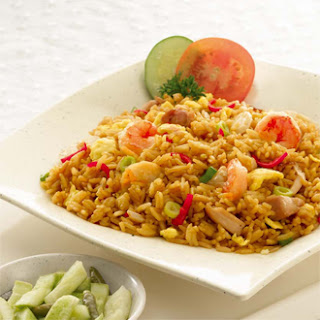Nasi goreng, literally meaning "fried rice" in Indonesian, can refer simply to fried pre-cooked rice, a meal including stir fried rice in small amount of cooking oil or margarine, typically spiced with kecap manis (sweet soy sauce), shallot, garlic, tamarind and chilli and accompanied with other ingredients, particularly egg, chicken and prawns. There is also another kind of nasi goreng which is made with ikan asin (salted dried fish) which is also popular across the country.
Nasi goreng is considered the national dish of Indonesia. There are many Indonesian cuisines but few national dishes. Indonesia's national dish knows no social barriers. It can be enjoyed in its simplest manifestation from a tin plate at a roadside warung, travelling night hawker's cart; eaten on porcelain in restaurants, or constructed at the buffet tables of Jakarta dinner parties. In 2011 an online poll by 35,000 people held by CNN International chose Nasi Goreng as the number two of their 'World’s 50 Most Delicious Foods' list after rendang.
Nasi goreng can trace its origin from Chinese fried rice, however it is not clear when Indonesians began to adopt the Chinese fried rice and create their own version of nasi goreng. The Chinese influences upon Indonesian cuisine can be seen in nasi goreng and mie goreng and appeared simultaneously with the introduction of stir frying technique that required the use of a Chinese wok. The trade between China and the Indonesian archipelago flourished since the era of Sriwijaya around the 10th century and intensified in the Majapahit era around the 15th century. By that time the Chinese immigrants began to remain in the archipelago, bringing along with them their culture and cuisine. Chinese people usually favor freshly cooked hot food, and in their culture it is considered a taboo to throw away uneaten foodstuffs. As a result, the previous day's leftover rice was often recooked in the morning. Previously, Indonesians probably simply sun-dried the leftover rice to make intip or rengginang (rice cracker), the dried rice also could be ground to make rice flour.
The main distinctions of Indonesian fried rice compared to its Chinese and other Asian counterparts was mainly the application of sweet soy sauce, and the preference of stronger and spicier taste. Indonesian nasi goreng often includes krupuk and bawang goreng (fried shallots) to give a crispy texture.
Nasi goreng was part of the dinner menu for Barack Obama's state visit to Indonesia in 2010, where he praised the dish, along with bakso (meatball soup) and emping (melinjo crackers made from Gnetum gnemon), as delicious.
Some of common nasi goreng recipes are:
The main distinctions of Indonesian fried rice compared to its Chinese and other Asian counterparts was mainly the application of sweet soy sauce, and the preference of stronger and spicier taste. Indonesian nasi goreng often includes krupuk and bawang goreng (fried shallots) to give a crispy texture.
Nasi goreng was part of the dinner menu for Barack Obama's state visit to Indonesia in 2010, where he praised the dish, along with bakso (meatball soup) and emping (melinjo crackers made from Gnetum gnemon), as delicious.
Variations
There is no single recipe of nasi goreng, every fried rice dish with certain mixtures, additions, ingredients, and toppings could lead to another recipe of nasi goreng. Usually, in Indonesian households, the ingredients of nasi goreng to be prepared for daily breakfast in the morning could be the leftovers of the previous day's meals preserved in the refrigerator, added with fresh vegetables and eggs. The basic ingredients of nasi goreng are rice left over from yesterday's meal and sliced or ground bumbu (spices) mixture of shallot, garlic, pepper, salt, tomato ketchup, sambal or chili sauce, and usually sweet soy sauce. Some variants may add saus tiram (oyster sauce), ang-ciu (chinese cooking red wine), kecap ikan (fish sauce), or kecap inggris (Worcestershire sauce). The texture of leftover cooked rice is considered more suitable for nasi goreng than that of newly cooked rice, as freshly cooked rice is too moist and soft.Some of common nasi goreng recipes are:
- Nasi goreng ayam: the most common nasi goreng with chicken, spices and sweet soy sauce, the color is golden brown
- Nasi goreng istimewa: special nasi goreng, usually refer to nasi goreng ayam with addition of fried eggs topping
- Nasi goreng ati ampela: nasi goreng with chicken gizzard and liver
- Nasi goreng sapi: nasi goreng with beef
- Nasi goreng kambing: nasi goreng with goat meat
- Nasi goreng pete: nasi goreng with green stinky beans, the combo variation of nasi goreng kambing-pete is also popular
- Nasi goreng sea food: nasi goreng with seafood such as cuttlefish, prawns, shellfish and fish
- Nasi goreng ikan asin: nasi goreng with salted fish usually without sweet soy sauce, as the result the color is paler than regular nasi goreng
- Nasi goreng teri Medan: nasi goreng with salted anchovy, specialty of Medan, North Sumatra
- Nasi goreng Aceh: Aceh style spicy shrimp nasi goreng
- Nasi goreng Jawa Timur: East Javanese style of nasi goreng, similar with nasi goreng ayam, but sweet soy sauce is replaced with tomato and chili sauce, as the result the color is red instead of golden brown. The Makassar nasi goreng also red, similar to this one
- Nasi goreng Magelangan: Central Javanese Magelang style of chicken nasi goreng mixed with noodles, it can be considered as the crossover between nasi goreng and mie goreng, it is sometimes called as nasi ruwet .
- Nasi goreng amplop : nasi goreng "enveloped" in thin omelette, can be found in Indonesia.
- Nasi goreng santri: means priest's nasi goreng, refer to a meatless vegetarian nasi goreng
- Nasi goreng sosis: nasi goreng with sausages
- Nasi goreng Hawaii or also called nasi goreng nanas: nasi goreng with pineapple
- Nasi goreng Hongkong: nasi goreng Hongkong style, more closely related to Chinese fried rice and similar to Japanese Chahan (Yakimeshi)
- Krupuk: various types of crackers, usually emping or prawn crackers
- Acar: pickles made from vinegar preserved cucumber, shallots, carrot, and small chilli pepper
- Sambal: somekind of traditional chilli sauce
- Slices of fresh vegetables: usually cucumber, tomato, lettuce and cabbage
- Fried eggs: fried eggs, omelette or shredded omelette could be served as nasi goreng toppings










1 komentar:
OpenRice is the Yelp of Asia. It shows a city’s most popular restaurants, ratings, menus, booking numbers, and everything in between. It’s widespread
in Southeast Asia and a better resource than Yelp. It has listings for Hong Kong, Malaysia, Indonesia, Singapore, Thailand, and the Philippines. The app
puts the power of the website at your fingertips.
App Name: OpenRice
Post a Comment
Thanks for visiting and comment